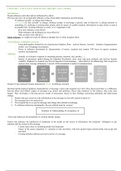CHAPTER 1 - INFLUENCE: DEFINITION, HISTORY AND A MODEL
Introduction
People influence each other and are influenced by others.
The most pervasive & recognizable influence comes from public information and advertising.
To influence people= to change their behavior
Advertising (to turn towards/ to change, influence people to encourage a specific type of behavior) is calling attention to
something: it’s notifying or warning other people, often by means of a public medium. Information in many forms is used to
accomplish this. Exerting influence is costly, so it’s important to ask:
- How does influence come about?
- What strategies and techniques are most effective?
- Why are these most effective?
Subtle influence: we might not recall all influence attempts but we often recognize them
A brief history of influence research
- Greek philosophers studied the art of persuasion (Sophists, Plato – truth & fairness, Aristotle – founder of argumentation
studies: use of language to persuade).
- Power to influence determined by characteristics of source, recipient and content. VIP focus on aspects recipient
sensitive and important.
Attitudes
- Attitude: an evaluative response to something (person, situation, idea, product…)
- Interest in persuasion spiked during the Industrial Revolution, since more and more products and services became
available. Emphasis in research was first on linguistics (form/meaning – when effective in influencing), then on process
analysis (how message influences). Laswell (1948) formulated a model of communication:
People (US government) became interested in attitude in influence research.
Hovland started testing hypotheses characteristics of message, source and recipient (see Ch2). They discovered there is a difference
between direct and indirect impact of messages (e.g. doctor and antibiotic, direct: take medicine 2x but indirect: after some time
forget). They developed a four-step process model of persuasion, based on their findings concerning attitudinal and behavioural
change:
1. People must pay attention to the information in the message (or else info cannot be taken in)
2. The message has to be understood.
3. The recipient has to accept the message and change their attitude accordingly.
4. To influence behaviour permanently, the new attitude must be retained.
Attention Understanding Acceptance
Retention
Each step influences the probability of eventual attitude change
Factors that influence the likelihood of completion of the model are the source of information, the recipients’ willingness to pay
attention and the content of the message.
- Content must relate to something people find important.
- Nature of the source important (+/- attention to info and effect, with time people forget untrustworthy and accept info
anyways)
- Existing attitudes influence pervasive power of a message.
,Together these steps and factors form the Yale model of persuasion:
This model fails to explain how the recipient (limited role) processes the information. Motivated people will take in info but
does not explain HOW.
As soon as a person is motivated to notice they will internalize content and shape attitudes and behavior.
Model: motivated people will take in info, does not state how the process works or whether it affects eventual outcome.
Inoculation theory (McGuire, 1964) looks into how people can arm themselves against information intended to influence them. Weak
arguments might act as virus triggering cognitive reaction which actually protects, reinforces & helps maintain existing attitude.
He proposes a 6-step model which is more dynamic
- Presentation
- Attention
- Comprehension
- Yielding
- Retention
- Behaviour
Greenwald (1968) developed McGuire’s ideas in his cognitive response theory: how is information processed, how does that affect
attitudes and how does this relate to existing attitudes? Whether attitude and behavior will be modified?
Greenwald and McGuire – How and when we accept/counterargue? (process of persuasion)
Advertising and influence
One of the first models describing how a recipient can
be influenced is the AIDA model by Strong (1925):
Attention, interest, desire, action. Later, the S
(satisfaction) was added to account for customer
loyalty.
Ethics (how far can we go?)
- Organizations regulate and prevent misleading advertisement (e.g. alcohol, tobacco ads)
- Subliminal influence regulated
- Influence techniques can be used for good or evil, (ir)responsible ways
, CHAPTER 2 – ATTITUDES AND BEHAVIOUR
Introduction
Influence attempts focus on changing attitudes, hoping this will alter behaviour. Attitudes refer to evaluative responses to a stimulus,
the attitude object (= person/object/product/organization/situation/idea). Because behaviour doesn’t just change, much attention has
been given to the topic of attitudes, originating in the 1920’s (primarily concerned with measuring attitudes).
Attitudes, attitude formation and behaviour
- Attitudes frequently shape our behavior.
- Attitudes are hard to measure, because it is a latent construct: the actual attitude is not directly observable, and has to be
inferred from visible responses. So we only have an indication of a person’s attitude (not measurable).
Three components of attitudes: (each component manifests an evaluation)
• Cognitive response (beliefs, opinions): Thoughts aroused by characteristics of the attitude object. We use these to form evaluative
(+/-) judgments.
• Affective response (feelings, emotions): The feelings an object elicits, either expressed or in the form of a physiological response.
They are instinctive and often coincide with cognitions. Can be non-verbal.
• Behavioural response (actions, conduct): Things like consumer buying (action tendencies)
Behaviour is often a consequence of the cognitive and affective
response (unbroken arrows). But behaviour can influence them too
(dotted arrows): i.e. if you are unhappy with a purchase.
Importance CR and AR determined by attitude object
- CR: babies, snakes
- AR: skincare





